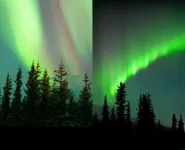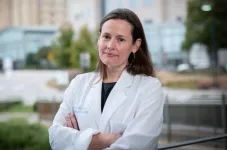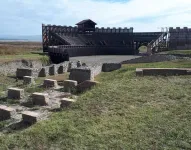(Press-News.org) The shimmering green, red and purple curtains of the northern and southern lights — the auroras — may be the best-known phenomena lighting up the nighttime sky, but the most mysterious are the mauve and white streaks called Steve and their frequent companion, a glowing green "picket fence."
First recognized in 2018 as distinct from the common auroras, Steve — a tongue-in-cheek reference to the benign name given a scary hedge in a 2006 children's movie — and its associated picket fence were nevertheless thought to be caused by the same physical processes. But scientists were left scratching their heads about how these glowing emissions were produced.
Claire Gasque, a University of California, Berkeley, graduate student in physics, has now proposed a physical explanation for these phenomena that is totally different from the processes responsible for the well-known auroras. She has teamed up with researchers at the campus's Space Sciences Laboratory (SSL) to propose that NASA launch a rocket into the heart of the aurora to find out if she's correct.
Vibrant auroras and glowing phenomena such as Steve and the picket fence are becoming more common as the sun enters the active period of its 11-year cycle, and November was a good month for Steve observations in the northern latitudes. Because all these transient luminous phenomena are triggered by solar storms and coronal mass ejections from the sun, the approaching solar maximum is an ideal time to study rare events like Steve and the picket fence.
Gasque described the physics behind the picket fence in a paper published last month in the journal Geophysical Research Letters and will discuss the results on Dec. 14 in an invited talk at the American Geophysical Union meeting in San Francisco.
She calculated that in a region of the upper atmosphere farther south than that in which auroras form, electric fields parallel to Earth's magnetic field could produce the color spectrum of the picket fence. If correct, this unusual process has implications for how physicists understand energy flow between Earth's magnetosphere, which surrounds and protects Earth from the solar wind, and the ionosphere at the edge of space.
"This would upend our modeling of what creates light and the energy in the aurora in some cases," Gasque said.
"The really interesting thing about Claire's paper is that we've known for a couple of years now that the Steve spectrum is telling us there's some very exotic physics going on. We just didn't know what it was," said Brian Harding, a co-author of the paper and an SSL assistant research physicist. "Claire's paper showed that parallel electric fields are capable of explaining this exotic spectrum."
The paper was a side project from Gasque's Ph.D. thesis, which is focused on the connection between events like volcanoes on Earth's surface and phenomena in the ionosphere 100 kilometers or more above our heads.
But after hearing about Steve — which has now become an acronym for Strong Thermal Emission Velocity Enhancement — at a conference in 2022, she couldn't resist looking into the physics behind Steve and the picket fence.
"It's really cool," she said. "It's one of the biggest mysteries in space physics right now."
The physics of Steve and picket fence
The common auroras are produced when the solar wind energizes particles in Earth's magnetosphere, often at altitudes higher than 1,000 kilometers above the surface. These energized particles spiral around Earth's magnetic field lines toward the poles, where they crash into and excite oxygen and nitrogen molecules in the upper atmosphere. When those molecules relax, oxygen emits specific frequencies of green and red light, while nitrogen generates a bit of red, but primarily a blue, emission line.
The colorful, shimmering curtains that result can extend for thousands of kilometers across the northern or southern latitudes.
Steve, however, displays not individual emission lines, but a broad range of frequencies centered around purple or mauve. And unlike auroras, neither Steve nor the picket fence emit blue light, which is generated when the most energetic particles hit and ionize nitrogen. Steve and the picket fence also occur at lower latitudes than the aurora, potentially even as far south as the equator.
Some researchers proposed that Steve is caused by ion flows in the upper atmosphere, referred to as subauroral ion drift, or SAID, though there's no well accepted physical explanation for how SAID could generate the colorful emissions.
Gasque's interest was sparked by suggestions that the picket fence's emissions could be generated by low-altitude electric fields parallel to Earth's magnetic field, a situation thought to be impossible because any electric field aligned with the magnetic field should quickly short out and disappear.
Using a common physical model of the ionosphere, Gasque subsequently showed that a moderate parallel electric field — around 100 millivolts per meter — at a height of about 110 km could accelerate electrons to an energy that would excite oxygen and nitrogen and generate the spectrum of light observed from the picket fence. Unusual conditions in that area, such as a lower density of charged plasma and more neutral atoms of oxygen and nitrogen, could potentially act as insulation to keep the electric field from shorting out.
"If you look at the spectrum of the picket fence, it's much more green than you would expect. And there's none of the blue that's coming from the ionization of nitrogen," Gasque said. "What that's telling us is that there's only a specific energy range of electrons that can create those colors, and they can't be coming from way out in space down into the atmosphere, because those particles have too much energy."
Instead, she said, "the light from the picket fence is being created by particles that have to be energized right there in space by a parallel electric field, which is a completely different mechanism than any of the aurora that we've studied or known before."
She and Harding suspect that Steve itself may be produced by related processes. Their calculations also predict the type of ultraviolet emissions that this process would produce, which can be checked to verify the new hypothesis about the picket fence.
Though Gasque's calculations don't directly address the on-off glow that makes the phenomenon look like a picket fence, it's likely due to wavelike variations in the electric field, she said. And while the particles that are accelerated by the electric field are probably not from the sun, the scrambling of the atmosphere by solar storms probably triggers Steve and the picket fence, as it does the common aurora.
Enhanced auroras exhibit a picket fence-like glow
The next step, Harding said, is to launch a rocket from Alaska through these phenomena and measure the strength and direction of the electric and magnetic fields. SSL scientists specialize in designing and building instruments that do just that. Many of these instruments are on spacecraft now orbiting Earth and the sun.
Initially, the target would be what's known as an enhanced aurora, which is a normal aurora with picket fence-like emissions embedded in it.
"The enhanced aurora is basically this bright layer that's embedded in the normal aurora. The colors are similar to the picket fence in that there's not as much blue in them, and there's more green from oxygen and red from nitrogen. The hypothesis is that these are also created by parallel electric fields, but they are a lot more common than the picket fence," Gasque said.
The plan is not only "to fly a rocket through that enhanced layer to actually measure those parallel electric fields for the first time," she said, but also send a second rocket up to measure the particles at higher altitudes, "to distinguish the conditions from those that cause the auroras." Eventually, she hopes for a rocket that will fly directly through Steve and the picket fence.
Harding, Gasque and colleagues proposed just such a sounding rocket campaign to NASA this fall and expect to hear back regarding its selection in the first half of 2024. Gasque and Harding consider the experiment an important step in understanding the chemistry and physics of the upper atmosphere, the ionosphere and Earth’s magnetosphere, and a proposal in line with the Low Cost Access to Space (LCAS) program sponsored by NASA for projects like this.
"It's fair to say that there's going to be a lot of study in the future about how those electric fields got there, what waves they are or aren't associated with, and what that means for the larger energy transfer between Earth's atmosphere and space," Harding said. "We really don't know. Claire's paper is the first step in the chain of that understanding."
Gasque expressed appreciation for the input from people who study the middle ionosphere, or mesosphere, and the stratosphere, whose ideas helped her puzzle out the solution.
"With this collaboration, we were able to make some really cool progress in this field," she said. "Honestly, it was just following our nose and being excited about it."
In addition to Harding, her other co-authors are Reza Janalizadeh of Pennsylvania State University in University Park, Justin Yonker of the Applied Physics Laboratory at Johns Hopkins University in Laurel, Maryland, and D. Megan Gillies of the University of Calgary in Alberta, Canada.
Partial support for this work was provided by the National Science Foundation (AGS-2010088), National Aeronautics and Space Administration (80NSSC21K1386) and Robert P. Lin Fellowship at UC Berkeley.
END
When is an aurora not an aurora?
Phenomena called “Steve” and “picket fence” are masquerading as auroras, graduate student argues
2023-12-08
ELSE PRESS RELEASES FROM THIS DATE:
Advisory panel issues field-defining recommendations for US government investments in particle physics research
2023-12-08
The High Energy Physics Advisory Panel (HEPAP) to the High Energy Physics program of the Office of Science of the U.S. Department of Energy and the National Science Foundation’s Division of Physics has released a new Particle Physics Project Prioritization Panel (P5) report, which outlines particle physicists’ recommendations for research priorities in a field whose projects — such as building new accelerator facilities — can take years or decades, contributions from thousands of scientists, and billions of dollars.
The 2023 P5 report represents the major activity in the field of particle physics that ...
Doctors discover many patients at UNC’s Inflammatory Bowel Disease Clinic screen positive for malnutrition
2023-12-08
CHAPEL HILL, NC — Eating food and absorbing its nutrients is an everyday occurrence, but this normal activity can look different for someone who suffers from inflammatory bowel disease. IBD, which includes Crohn’s disease and ulcerative colitis, can cause chronic inflammation of the digestive tract – which for many reasons can lead to malnutrition. This malnourished state is associated with an increased risk of morbidity and mortality, and new findings show that many patients in IBD clinic screen positive for malnutrition, leading to the critical need for same-day ...
BNL: Advisory panel issues field-defining recommendations for U.S. government investments in particle physics research
2023-12-08
The following news release on the 2023 Particle Physics Project Prioritization Panel (P5) report is based on one issued today by the American Physical Society (APS) with added content specific to the U.S. Department of Energy’s (DOE) Brookhaven National Laboratory. For more information about Brookhaven Lab’s research in particle physics, contact: Karen McNulty Walsh, kmcnulty@bnl.gov, (631) 344-8350. For APS media inquiries, contact Anna Torres, torres@aps.org, (301) 209-3605.
WASHINGTON, ...
International collaboration uses faculty member’s research on ancient Roman migration, seeks to understand Balkan genomic history
2023-12-08
STARKVILLE, Miss.––A Mississippi State University anthropologist’s bioarchaeological analysis and bone samples from ancient Roman burial sites were crucial in the development of new research regarding Roman and Balkan migration featured this week in Cell, a prestigious peer-reviewed journal.
Anna Osterholtz, an associate professor in the Department of Anthropology and Middle Eastern Cultures, provided her research on the “lived experiences” of the Romans in Croatia. She currently works closely with museum ...
USF Health Heart Institute doctors are upbeat about cardiac regeneration
2023-12-08
But when those batteries – heart muscle cells called cardiomyocytes − short circuit and die, the damage can be devastating. The damage to the heart muscle is usually permanent, leaving the heart unable to pump the way it should.
That’s the subject of a new study by a team that includes two USF Health doctors who reported their findings in Circulation, the flagship journal of the American Heart Association.
“An injury like a heart attack creates a massive loss of cardiomyocytes, and you can’t renew them,’’ said Da-Zhi Wang, PhD, director of the Center for Regenerative Medicine in the USF Health Heart Institute and Morsani College ...
AI-driven breakthroughs in cells study: SFU-UBC collaboration introduces "MCS-detect" for advancements in super-resolution microscopy
2023-12-08
In 2014, the Nobel Prize in Chemistry celebrated the breakthroughs in super-resolution microscopy, a technology that allows us to capture highly detailed images of small parts of cells using fluorescent microscopy. Despite its success, the resolution of super-resolution microscopy still can’t show tiny distances between organelles in cells. This gap is where Artificial Intelligence (AI) and Biomedical Computer Vision intersect, as researchers from SFU Computing Science and UBC School of Biomedical Engineering and Life Sciences Institute reveal how AI enhances super-resolution microscopy ...
Advisory panel issues field-defining recommendations for investments in particle physics research
2023-12-08
Contributions from Argonne will drive innovation in particle physics and shed light on outstanding mysteries in the field.
Yesterday marked the release of a highly anticipated report from the Particle Physics Project Prioritization Panel (P5), unveiling an exciting new roadmap for unlocking the secrets of the cosmos through particle physics.
The report was released by the High Energy Physics Advisory Panel to the High Energy Physics program of the Office of Science of the U.S. Department of Energy (DOE) and ...
$3.8 million NIH grant to fund Southwest Center on Resilience for Climate Change and Health
2023-12-08
A $3.8 million grant from the National Institute of Environmental Health Sciences, a division of the National Institutes of Health, will fund planning for the Southwest Center on Resilience for Climate Change and Health, or SCORCH, at the University of Arizona fund planning for the Southwest Center on Resilience for Climate Change and Health, or SCORCH, at the University of Arizona Mel and Enid Zuckerman College of Public Health. The center will focus on research and programs to help communities in Arizona and other hot, dry geographic regions adapt to climate-driven health ...
What happens when the brain loses a hub?
2023-12-08
A University of Iowa-led team of international neuroscientists have obtained the first direct recordings of the human brain in the minutes before and after a brain hub crucial for language meaning was surgically disconnected. The results reveal the importance of brain hubs in neural networks and the remarkable way in which the human brain attempts to compensate when a hub is lost, with immediacy not previously observed.
Hubs are critical for connectivity
Hubs are everywhere. The hub of a bicycle wheel, with spokes shooting ...
Study reveals Zika’s shape-shifting machinery—and a possible vulnerability
2023-12-08
Viruses have limited genetic material—and few proteins—so all the pieces must work extra hard. Zika is a great example; the virus only produces 10 proteins. Now, in a study published in the journal PLOS Pathogens, researchers at Sanford Burnham Prebys have shown how the virus does so much with so little and may have identified a therapeutic vulnerability.
In the study, the research team showed that Zika’s enzyme—NS2B-NS3—is a multipurpose tool with two essential functions: breaking up proteins (a protease) and dividing its own double-stranded RNA into single strands (a helicase).
“We found that Zika’s ...
LAST 30 PRESS RELEASES:
Johns Hopkins-led team creates first map of nerve circuitry in bone, identifies key signals for bone repair
UC Irvine astronomers spot largest known stream of super-heated gas in the universe
Research shows how immune system reacts to pig kidney transplants in living patients
Dark stars could help solve three pressing puzzles of the high-redshift universe
Manganese gets its moment as a potential fuel cell catalyst
“Gifted word learner” dogs can pick up new words by overhearing their owners’ talk
More data, more sharing can help avoid misinterpreting “smoking gun” signals in topological physics
An illegal fentanyl supply shock may have contributed to a dramatic decline in deaths
Some dogs can learn new words by eavesdropping on their owners
Scientists trace facial gestures back to their source. before a smile appears, the brain has already decided
Is “Smoking Gun” evidence enough to prove scientific discovery?
Scientists find microbes enhance the benefits of trees by removing greenhouse gases
KAIST-Yonsei team identifies origin cells for malignant brain tumor common in young adults
Team discovers unexpected oscillation states in magnetic vortices
How the brain creates facial expressions
Researchers observe gas outflow driven by a jet from an active galactic nucleus
Pitt student finds familiar structure just 2 billion years after the Big Bang
Evidence of cross-regional marine plastic pollution in green sea turtles
Patients with clonal hematopoiesis have increased heart disease risk following cancer treatment
Stem cell therapy for stroke shows how cells find their way in the brain
Environment: Up to 4,700 tonnes of litter flows down the Rhine each year
Maternal vaccine receipt and infant hospital and emergency visits for influenza and pertussis
Interim safety of RSVpreF vaccination during pregnancy
Stem cell engineering breakthrough paves way for next-generation living drugs
California grants $7.4 million to advance gene-edited stem cell therapy for Friedreich’s ataxia
Victoria’s Secret grant backs cutting-edge ovarian cancer research
Research paves the way for safer colonoscopy bowel prep for people with compromised gut health
JMIR Publications and Sweden's National Library announce renewal and expansion of flat-fee unlimited open access partnership for 2026
A new 3D-printed solar cell that’s transparent and color-tunable
IV iron is the cost-effective treatment for women with iron deficiency anemia and heavy menstrual bleeding
[Press-News.org] When is an aurora not an aurora?Phenomena called “Steve” and “picket fence” are masquerading as auroras, graduate student argues




